Ever wonder how to create a space that feels both calming and authentic, where beauty lies in imperfection? Wabi sabi interior design has captivated many for its effortlessly graceful embrace of natural, imperfect elements that promote a sense of peace and harmony. This Japanese philosophy celebrates the beauty of aging, wear, and irregularity, making interiors feel warm, genuine, and deeply connected to nature. It’s no wonder that more homeowners are turning to Wabi sabi-inspired spaces to escape the chaos and find serenity in simplicity.
In this article, you’ll discover a wealth of inspiring ideas to incorporate the essence of Wabi sabi into your home. From textured walls and weathered wood to organic shapes and handcrafted accents, these practical tips will guide you toward achieving a balanced, natural aesthetic. Whether you’re aiming for subtle touches or a full Wabi sabi makeover, you’ll find creative ways to infuse your space with tranquil beauty and effortless charm.
1. Embrace Imperfect Textured Wall Finishes for Organic Charm
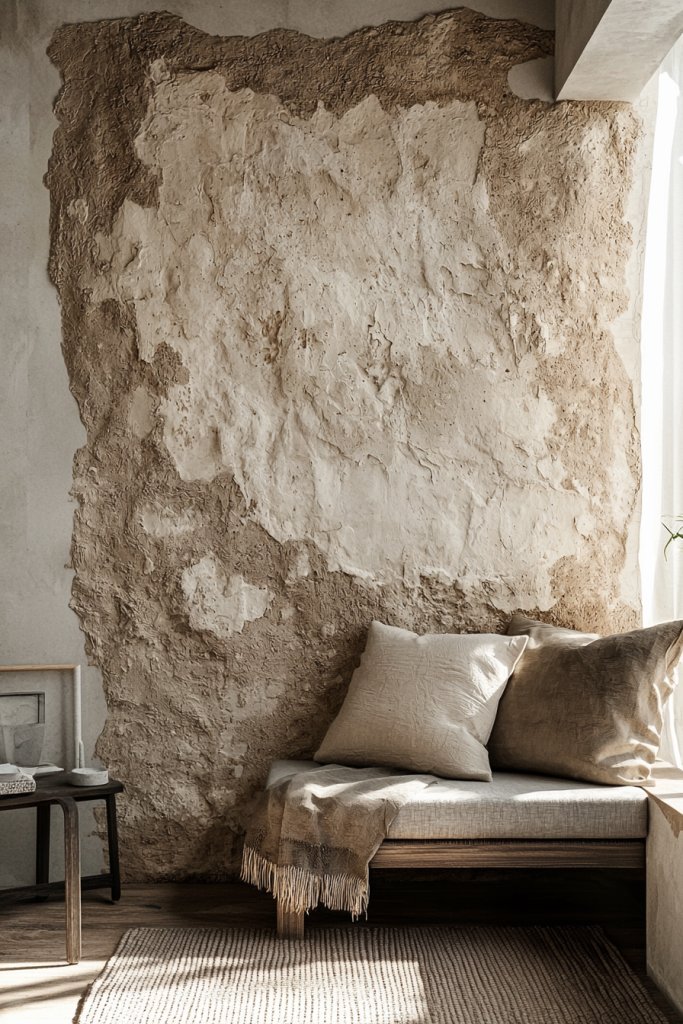
Embracing imperfect textured wall finishes is a simple yet powerful way to add authentic character and organic charm to your space. It celebrates the beauty of imperfection, creating a warm, inviting atmosphere that feels both relaxing and uniquely yours.
Imagine walls with a hand-troweled plaster surface, where subtle ridges and uneven patches catch the light differently throughout the day. The colors are soft and muted, like warm beige, blush, or earthy taupe, blending seamlessly with natural materials like raw wood or ceramic accents. You can feel the tactile variation under your fingertips, with a slightly rough texture that invites close inspection. The space exudes a sense of relaxed imperfection—like a well-loved, timeworn treasure—making it both soothing and inspiring.
Recreating this look is easier than you might think. Start by choosing a textured plaster or stucco finish, which you can apply yourself with a trowel or sponge for a handmade feel, or hire a professional for a flawless, artisanal look. If a full wall treatment feels daunting, consider applying textured wallpaper with a subtle, organic pattern. Use natural, earthy paint colors like warm clay or soft sand as your base. Pair these textured walls with rustic wooden furniture, woven textiles, and handcrafted ceramics to enhance the authentic, Wabi Sabi vibe—creating a space that feels both imperfect and beautifully harmonious.
2. Incorporate Weathered Wood Furniture with Visible Grain and Knots

Embracing weathered wood furniture with visible grain and knots is a simple yet powerful way to bring authentic Wabi Sabi beauty into your space. These pieces celebrate natural imperfections, creating a warm, inviting atmosphere that feels both grounded and unique.
Imagine a dining table crafted from reclaimed oak with rich, textured grains and charming knots that tell their own stories. Surrounding it are side tables and chairs with a worn, matte finish that showcases the wood’s natural character. The furniture’s rustic appeal is complemented by soft, neutral textiles—perhaps a linen cushion or a wool throw—adding layers of tactile comfort. The overall scene exudes a sense of history and natural harmony, inviting you to relax and enjoy the imperfect beauty of each piece.
To incorporate weathered wood furniture into your home, start by seeking out reclaimed or vintage wooden pieces at thrift stores or specialty shops. Look for tables, chairs, or shelves that display visible grain, knots, and a slightly distressed finish. You can treat new wood with a matte stain or opaque wax to enhance its aged look, or leave it raw for a more natural appearance. Simply place these pieces in a space with neutral-colored textiles and minimal decor to highlight their rustic charm, creating a tranquil, Wabi Sabi-inspired environment that feels effortlessly authentic.
3. Use Neutral Color Palettes Inspired by Nature for a Calm Atmosphere

Creating a calming Wabi Sabi interior begins with embracing a soft, neutral color palette inspired by the gentle hues found in nature—think warm beiges, muted greys, and subtle creams. These understated shades set the stage for a peaceful and harmonious environment, allowing you to unwind and reconnect with simplicity. When combined thoughtfully, they evoke a sense of quiet elegance that feels both grounding and inviting.
Imagine a living space where textured walls are painted in delicate sand tones or finished with natural plaster that offers a slightly uneven, organic surface. The furniture features earthy shades like taupe or oatmeal, with fabrics such as linen or cotton in soft, matte finishes. Accents may include ceramic vases in muted clay colors, woven baskets in natural fibers, and stone or pebble decorative elements that add tactile interest. The overall atmosphere is serene, with a visual rhythm created by subtle variations in color and texture, inviting you to relax into the space. The gentle palette and raw materials evoke the soothing sounds of wind or water, making the environment feel like a natural retreat.
To recreate this tranquil look, start by choosing neutral paint colors like warm beige or light grey for your walls, and opt for natural fiber textiles such as linen curtains or wool throws. Incorporate furniture with visible wood grains or matte finishes in similar earthy tones—consider low-profile sofas or simple wooden tables. You can find ceramic or stone decorative objects at craft stores or make your own with clay or natural stones. Keep the arrangement minimal and balanced, focusing on a few meaningful pieces that highlight the imperfect beauty of natural materials. With these easy-to-find elements, you’ll create a calming, Wabi Sabi-inspired space that feels effortlessly harmonious.
4. Select Rustic Ceramics and Pottery as Decorative Accents
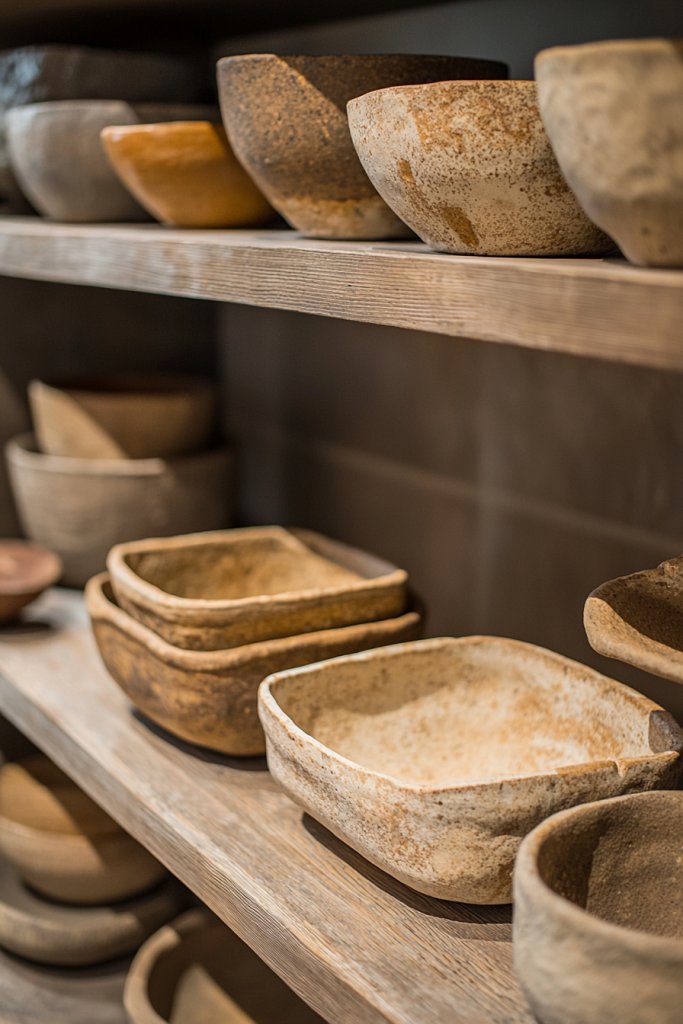
Adding rustic ceramics and pottery as decorative accents is a simple yet powerful way to infuse your space with authentic Wabi Sabi charm. These handcrafted pieces bring a sense of history, imperfection, and natural beauty that perfectly complements the philosophy of embracing the imperfect and transient.
Imagine a collection of earthy-toned vases, bowls, and pitchers with uneven surfaces, subtle cracks, and irregular shapes displayed on open shelves or clustered on a wooden table. The ceramics feature muted colors like warm beige, soft gray, and gentle terracotta, their textures ranging from matte to slightly rough. These pieces evoke a tactile experience, inviting you to touch and appreciate their unique imperfections. When illuminated by soft, warm lighting, they create a calming, grounded atmosphere that feels both cozy and timeless.
To incorporate rustic ceramics into your home, start by sourcing handcrafted pottery from local artisans or vintage shops that emphasize natural, unglazed finishes. Arrange a few select pieces on open shelving, sideboards, or as centerpiece displays on dining or coffee tables. You can also mix and match different shapes and sizes for an eclectic, organic look. No need for perfection—embrace the slight variations and rough edges, which add character and authenticity to your space. A simple collection of these imperfect yet beautiful objects will instantly evoke the serene, imperfect harmony of Wabi Sabi.
5. Integrate Simple Linen or Cotton Textiles with Worn-In Feel
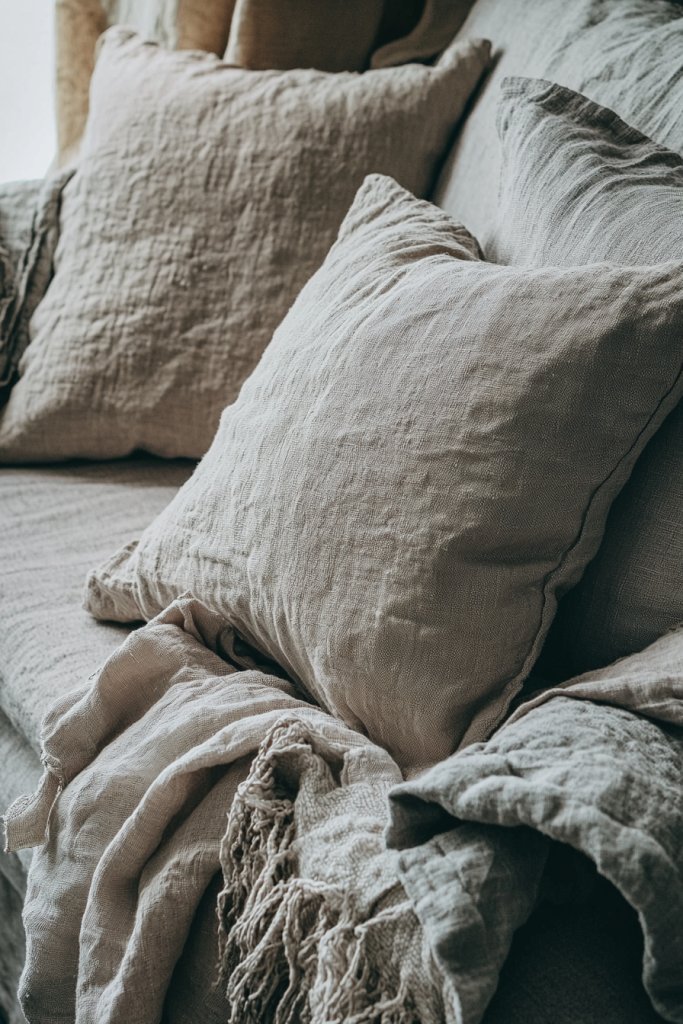
Incorporating simple linen or cotton textiles with a worn-in feel instantly introduces a sense of relaxed, natural beauty to your space. These textiles embody the Wabi Sabi philosophy by emphasizing imperfection and authentic craftsmanship, creating a cozy, inviting atmosphere that feels both effortless and thoughtfully curated.
Imagine soft, slightly crumpled linen pillow covers in muted beige or warm oatmeal draped casually on a low, rustic bench. A well-loved cotton throw with frayed edges and a subtle weave pattern might be casually tossed over a vintage armchair, inviting touch and comfort. The textures are tactile, with a slightly rough, organic feel that contrasts beautifully with the smoothness of ceramics or wood accents. The gentle, matte finish of these fabrics complements the natural color palette inspired by earth tones, while their worn-in look adds warmth and personality to the room. The overall effect is a space that feels lived-in, genuine, and effortlessly harmonious.
To recreate this look, start by choosing linen or cotton textiles with a naturally relaxed appearance—think about lightly wrinkled, slightly irregular weaves. Look for pieces that have a vintage or handmade vibe, such as a linen pillow cover with frayed edges or a cotton blanket with a subtle, uneven stitch. You can find affordable options at thrift stores or craft markets, or even DIY with natural fabric and simple sewing. Drape these textiles casually over furniture, mixing and matching textures and shades for an organic, layered look. Keep the arrangement simple and unpretentious, focusing on creating a cozy, imperfect charm that embodies the spirit of Wabi Sabi in your home.
6. Display Handcrafted Woven Baskets and Mats for Natural Warmth
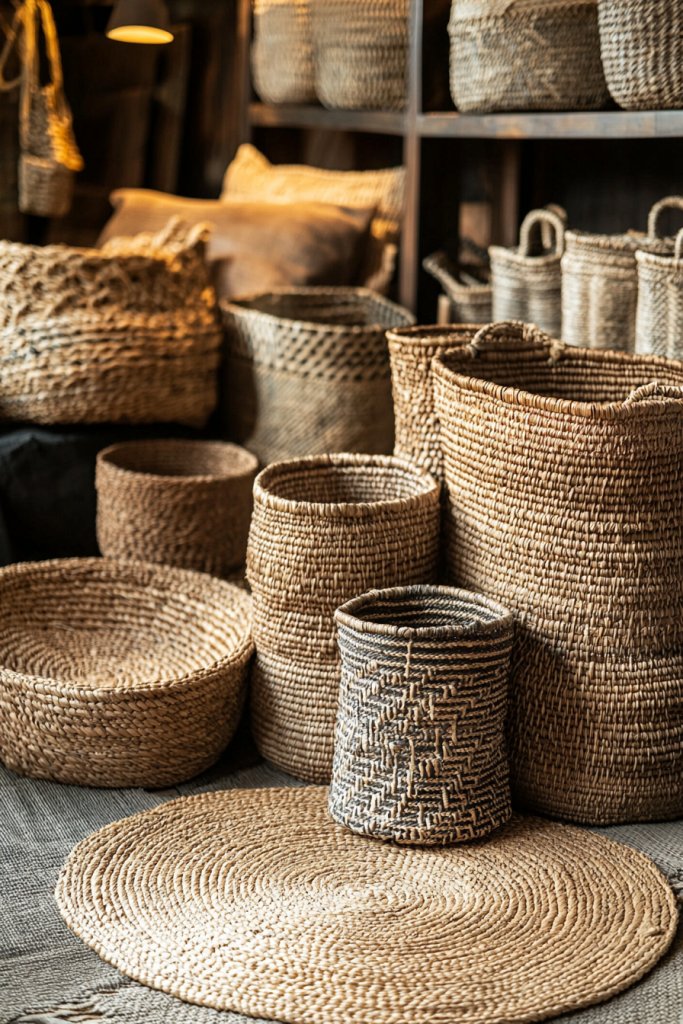
Adding handcrafted woven baskets and mats introduces a tactile, warm element that embodies the essence of Wabi Sabi’s appreciation for natural imperfections. These pieces, often made from rattan, jute, or seagrass, feature uneven weaves and subtle variations that celebrate their artisanal craftsmanship. When displayed in living rooms or entryways, they lend a cozy, inviting vibe, reminiscent of traditional Japanese craftsmanship. Their earthy tones—warm browns, sandy beiges, and muted greys—blend seamlessly with neutral palettes and textured surfaces, enhancing the organic feel of the space.
Visually, these woven accents vary in size and shape, from small round baskets perfect for holding keys or trinkets, to large flat mats that serve as area rugs or wall hangings. Their rough, unfinished edges and visible fibers create a beautiful contrast against smooth ceramics or soft textiles. Touch-wise, they are slightly coarse but warm, inviting physical interaction that fosters a sense of comfort. The natural scent of the fibers adds an extra layer of sensory richness, grounding the space deeply in nature.
To incorporate these into your home, start with a few small baskets to place on shelves or hang on hooks, or opt for a large woven mat as a centerpiece on the floor. Look for pieces crafted from sustainable materials like jute or seagrass, which you can find at local markets or online stores specializing in handmade goods. Simply arrange them near entryways or open shelving, and enjoy the subtle warmth and texture they bring to your Wabi Sabi-inspired sanctuary.
7. Add Asymmetrical Shelving to Highlight Raw, Unpolished Materials
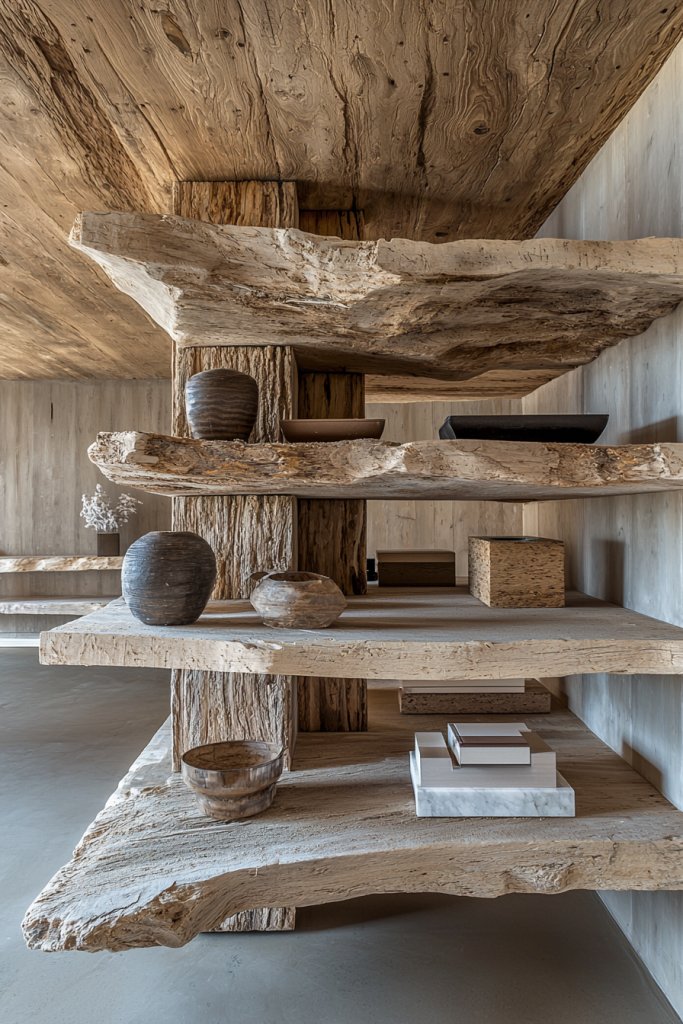
Asymmetrical shelving is a compelling way to emphasize the beauty of raw, unpolished materials while creating visual interest and a sense of organic balance. These shelves often feature uneven lengths, rough edges, and natural wood or stone supports, deliberately avoiding symmetry to reflect Wabi Sabi’s embrace of imperfection. When installed on a textured wall or alongside weathered surfaces, they serve as functional yet artistic displays for curated objects, ceramics, or simple decor pieces, all while reinforcing the natural, unrefined aesthetic.
Visually, these shelves appear as if they’ve been handcrafted by nature itself—think irregular planks of reclaimed wood or slabs of rough stone suspended by simple metal brackets or ropes. They create a layered, dynamic look that draws the eye across different levels, encouraging a relaxed, unpretentious atmosphere. The textures are tactile and earthy, with visible grain, knots, and natural imperfections adding character and depth. The overall effect is a space that feels authentic, calm, and rooted in nature.
To implement this idea, select materials like reclaimed wood planks or rough-hewn stone slabs. Use simple mounting hardware—such as sturdy brackets or natural fiber ropes—that complement the raw aesthetic. Arrange the shelves at varying heights and depths, and display ceramic vessels, vintage books, or small sculptures to create a curated, imperfect balance. This approach invites a sense of discovery and appreciation for the beauty found in natural irregularities.
8. Choose Low, Slouchy Seating for a Relaxed, Unpretentious Look
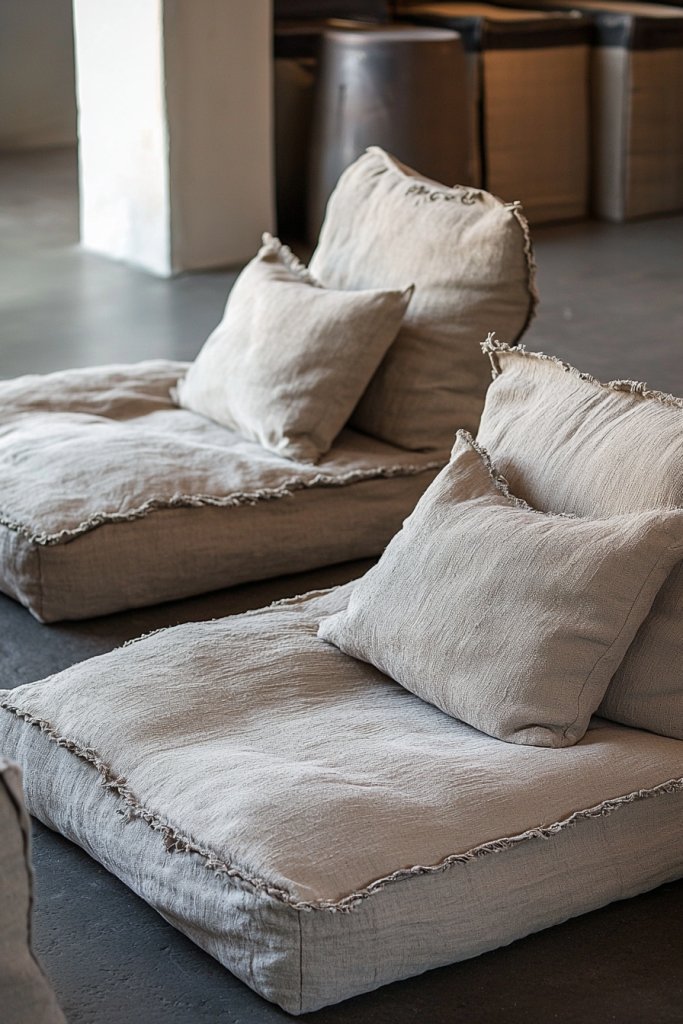
Opting for low, slouchy seating introduces an inviting, laid-back vibe that perfectly captures Wabi Sabi’s emphasis on comfort and imperfection. These pieces often include oversized cushions, floor chairs, or poufs made from natural fabrics like linen, cotton, or wool, with relaxed shapes that encourage lounging and casual gatherings. Their slightly saggy, unstructured appearance offers a sense of authenticity and effortless charm, making your space feel more lived-in and genuine.
In visual terms, this seating style features soft, rounded forms that appear as if they have been gently used and loved over time. Think of a large, plush floor cushion with a slightly wrinkled cover in muted earth tones—like warm taupe, dusty grey, or faded ochre. The textures are often tactile and cozy, with linen or wool covers that invite touch and comfort. When arranged in a corner or around a low table, they create a flexible, intimate setting that promotes relaxation and mindfulness.
To recreate this look, choose oversized cushions or poufs from natural, breathable fabrics—look for options with visible stitching or intentionally worn-in finishes for added character. Place them on neutral-toned rugs or directly on unfinished wooden floors, and layer with soft throws or blankets. This seating style requires minimal assembly and is perfect for creating a cozy, unpretentious nook that encourages slow living and genuine comfort.
9. Incorporate Stone or Pebble Elements in Surfaces and Decor
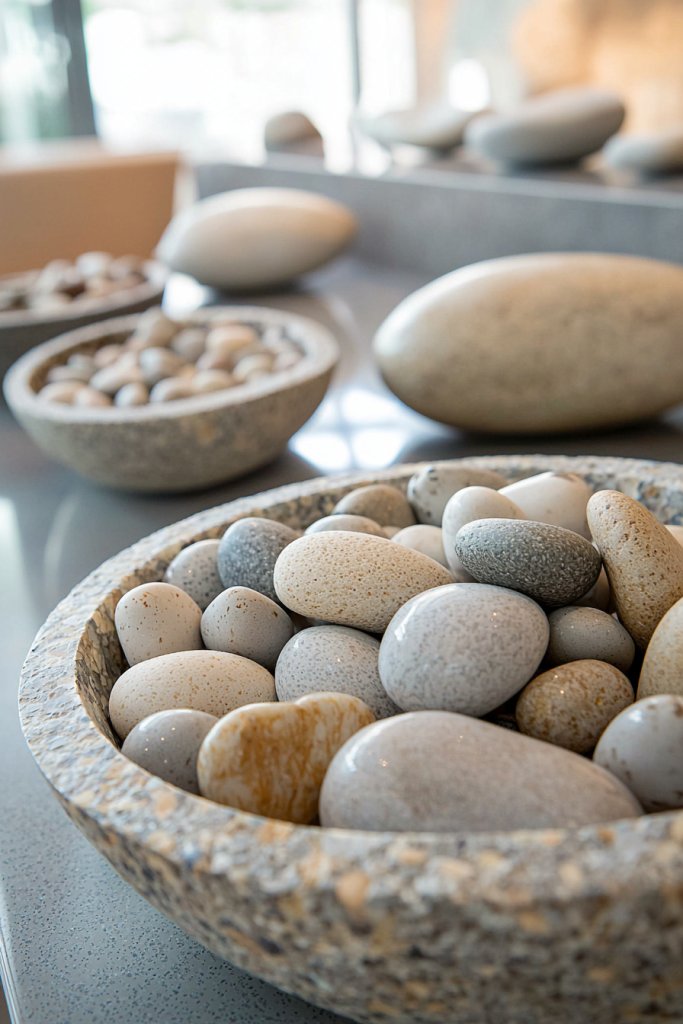
Integrating stone or pebble elements into your interior design provides a grounding, elemental quality that aligns perfectly with Wabi Sabi’s reverence for natural materials. These elements can be incorporated through countertops, decorative bowls, or as standalone sculptures, adding tactile richness and visual weight to the space. Their naturally irregular shapes and textures evoke the calming, imperfect beauty of nature, creating a serene atmosphere that feels both raw and refined.
Visually, stone surfaces—such as rough granite or textured concrete—bring an earthy, substantial presence, while small pebbles arranged in bowls or trays introduce subtle patterns and textures. When placed on tables or shelves, they serve as focal points that draw attention to their natural imperfections and variations in color—think warm browns, muted greys, or subtle tans. The tactile experience of these stones invites touch, and their cool, solid feel enhances the sensory depth of the environment.
To incorporate stone or pebbles, start with a simple bowl filled with smooth river stones or a slab of raw stone as a side table surface. Use concrete or stone countertops in kitchens or bathrooms for an authentic, Wabi Sabi touch. For a more subtle approach, scatter small pebbles on a tray or within a glass vessel. Sourcing natural stones from local markets or garden centers makes this easy and budget-friendly, transforming everyday surfaces into calming, nature-inspired elements.
10. Use Minimalist Lighting with Organic-Shaped Lamps and Lampshades
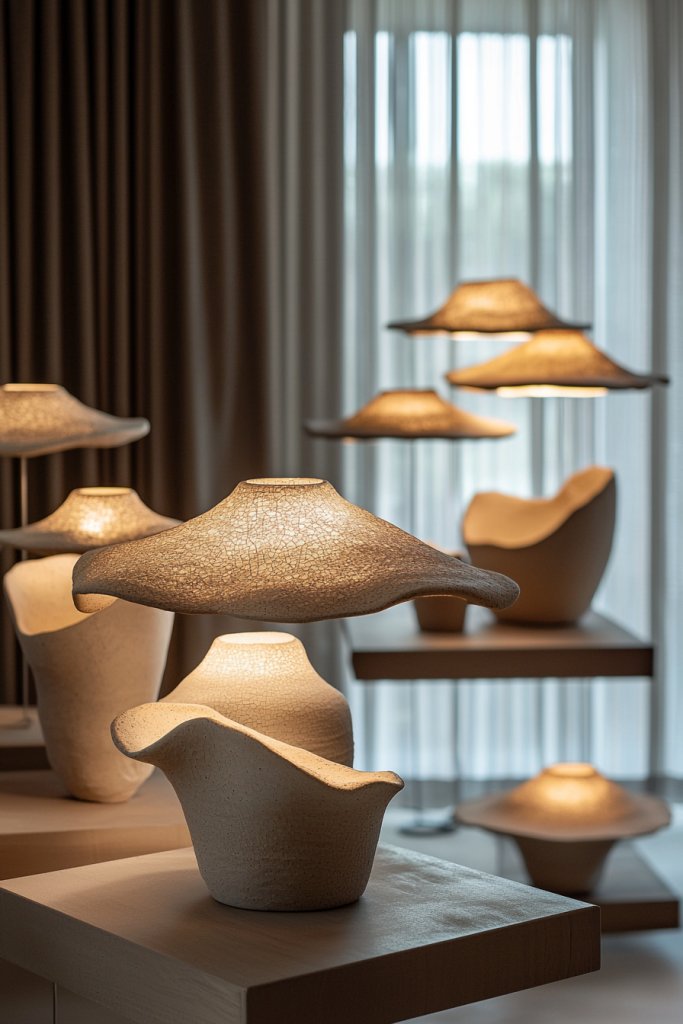
Lighting plays a crucial role in highlighting the natural textures and imperfect beauty of a Wabi Sabi interior. Opting for minimalist fixtures with organic shapes—such as irregular ceramic lamps, hand-blown glass lampshades, or wooden lamps with flowing lines—adds warmth and an understated elegance. These lighting pieces create soft, diffused illumination that enhances the cozy, tranquil ambiance while emphasizing the raw materials and imperfect forms they feature.
Visually, these lights have an artisanal quality, with shapes that mimic natural forms—think a bulbous, uneven ceramic base or a gently curved wooden stand. The light emitted is gentle and warm, casting subtle shadows that accentuate textured walls, woven textiles, and unpolished surfaces. The organic shapes serve as focal points in the space, harmonizing with the overall natural aesthetic and encouraging a sense of calm and mindfulness.
To implement, choose fixtures with simple, natural finishes—unglazed ceramics, matte metals, or lightly stained wood. Position table lamps on side tables or use pendant lights with irregular, handcrafted shades over dining or reading areas. Keep the design minimal to avoid clutter, allowing the natural beauty of the materials and forms to take center stage, creating a serene, inviting glow that complements the Wabi Sabi philosophy.
11. Decorate with Vintage or Reclaimed Metal Objects for a Touch of Age and Patina

Adding vintage or reclaimed metal objects brings a unique sense of history and character to a Wabi Sabi interior. These pieces, often showing subtle rust, patina, or wear, evoke a sense of age and authenticity that perfectly complements the natural, imperfect aesthetic. Think of aged metal trays, antique hardware, or weathered iron sculptures that serve as both functional and decorative accents, seamlessly blending old-world charm with modern simplicity.
Visualize a space where a reclaimed copper kettle sits next to a weathered brass tray on a rustic wooden table, its surface glowing softly with a warm, aged patina. Old metal candleholders with a slightly tarnished finish add a cozy, nostalgic touch, while vintage iron hooks or brackets frame a simple, rough-hewn shelf. The warm tones and textured surfaces create a tactile experience, inviting you to appreciate the imperfect beauty of aged metals. The overall effect is one of understated elegance imbued with a sense of history and life lived.
To incorporate this idea easily, start by sourcing vintage or reclaimed metal objects from thrift stores, flea markets, or online marketplaces specializing in antiquities. Choose pieces with visible signs of age—rust, scratches, or patina—that add character without compromising safety. Arrange these objects thoughtfully on open shelves, side tables, or as standalone decorative pieces. Combining different metal tones and textures can enhance the layered, organic feel typical of Wabi Sabi interiors, making your space feel warm, soulful, and uniquely yours.
12. Incorporate Organic-Shaped Mirrors with Worn Frames

Organic-shaped mirrors with worn or distressed frames are a beautiful way to introduce natural beauty and visual interest into a Wabi Sabi interior. These mirrors, often irregular in form and featuring frames that look gently weathered or chipped, emphasize imperfection and authenticity. They serve as both functional items and artful focal points that reflect the subtle beauty of natural forms and textures.
Imagine a mirror with an uneven, hand-shaped outline, its frame carved from reclaimed wood with a faded, peeling paint finish. The glass may have slight imperfections or a soft, hazy reflection that enhances the sense of age and authenticity. When placed above a rustic console or leaning against a textured wall, this mirror creates a sense of organic flow, catching light and bouncing it around with a gentle, imperfect charm. The worn frame and irregular shape evoke the natural, unrefined beauty celebrated in Wabi Sabi.
To add this element to your home, look for mirrors with irregular or asymmetrical shapes and frames that feature distressed finishes or weathered textures. These can often be found in antique shops, salvage yards, or online marketplaces specializing in vintage or handmade pieces. Hang or lean the mirror in a space where it can reflect natural light and complement other raw materials like wood or stone. The key is to embrace the imperfections—allow the worn edges and irregular contours to become a focal point that enhances your interior’s authentic, serene vibe.
13. Display Raw, Unfinished Wooden Accents as Focal Points
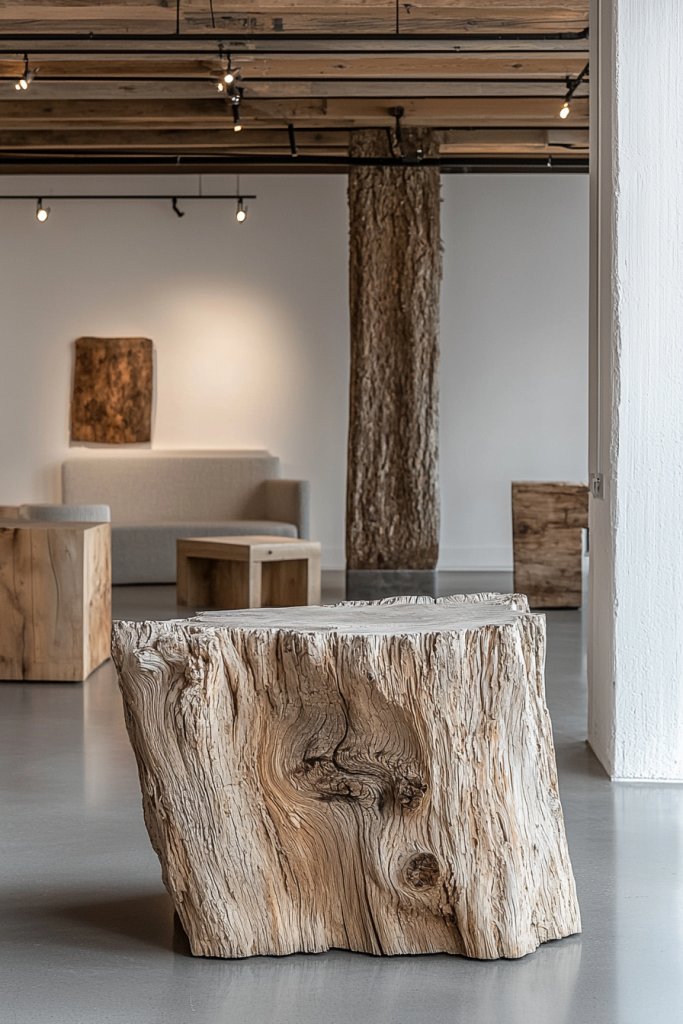
Raw, unfinished wooden accents embody the heart of Wabi Sabi’s appreciation for natural, unrefined beauty. These pieces, whether as furniture, sculptures, or decorative objects, highlight the organic grains, knots, and textural imperfections of wood, creating a warm and earthy focal point in any space. Their simplicity and natural irregularities foster a calming, grounded atmosphere.
Picture a chunky, roughly-hewn wooden bench with visible bark edges and a surface marked by natural knots and grain variations. Or perhaps a sculptural wooden bowl with a rugged, uneven rim that feels both primitive and elegant. These accents are often placed as centerpieces or statement pieces, encouraging tactile interaction and visual appreciation for nature’s imperfections. The raw finish allows the wood’s natural character to shine, adding warmth and a sense of authenticity to the room.
Begin by sourcing unfinished or reclaimed wood from local carpentry shops, salvage yards, or online suppliers. You can also create your own by selecting a piece of driftwood or a fallen branch, sanding it lightly to retain its natural texture. Use these accents as standalone features or pair them with softer textiles and muted colors to enhance their organic appeal. The idea is to celebrate the natural imperfections and irregularities, making your interior feel more alive, genuine, and in harmony with nature.
14. Opt for Simple, Functional Furniture with Visible Joints and Natural Finishes
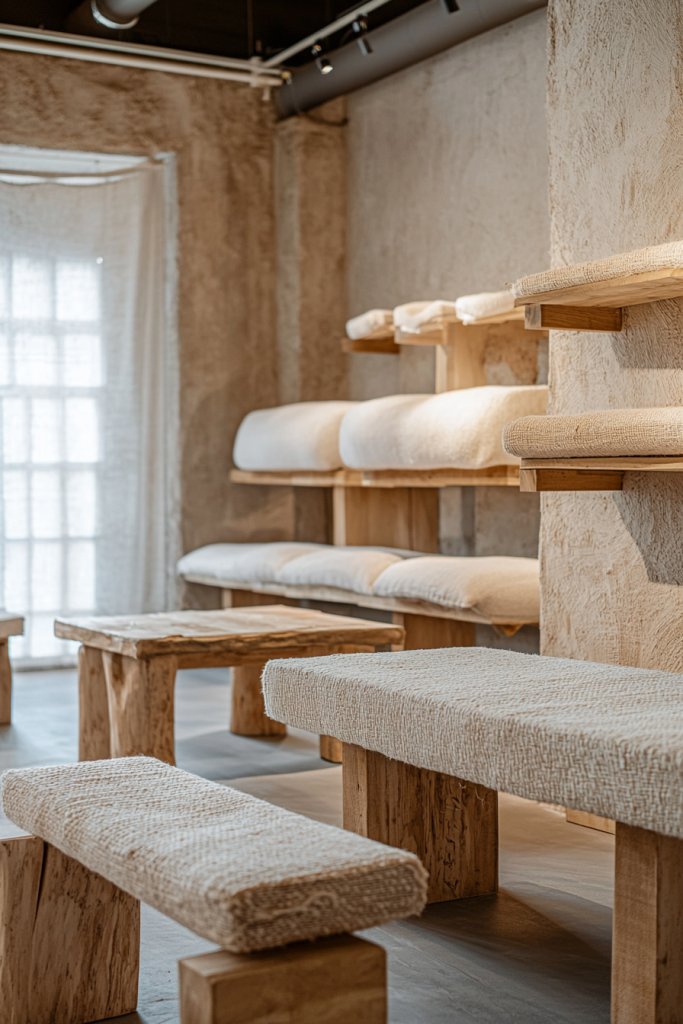
Choosing furniture that emphasizes simplicity, functionality, and natural materials is essential to achieving a true Wabi Sabi look. Pieces with visible joints, handcrafted details, and natural finishes highlight the beauty of craftsmanship and the raw qualities of materials. These furnishings serve practical needs while quietly celebrating imperfections, making the space feel honest and unpretentious.
Visualize a low-profile, solid wood dining table with visible peg joints and a matte, oil-finished surface that showcases the wood’s natural grain. Accompany it with straightforward, slouchy linen chairs that emphasize comfort and simplicity. The furniture’s unpolished, natural look creates a calming, harmonious environment, emphasizing function over form and embracing the beauty of imperfect construction. This approach fosters a sense of authenticity and timelessness that is central to Wabi Sabi.
To incorporate this style, seek out handcrafted or well-made, minimalist furniture that highlights natural materials like wood or stone. Look for pieces with visible joints, subtle imperfections, or hand-finished surfaces—these details add character. If you’re on a budget, consider DIY projects or refinishing secondhand furniture by stripping paint or applying natural oils. The goal is to prioritize honest construction and natural finishes, creating a space that feels both functional and quietly beautiful through its imperfections.
15. Create a Sense of Balance with Asymmetrical Arrangements of Decor
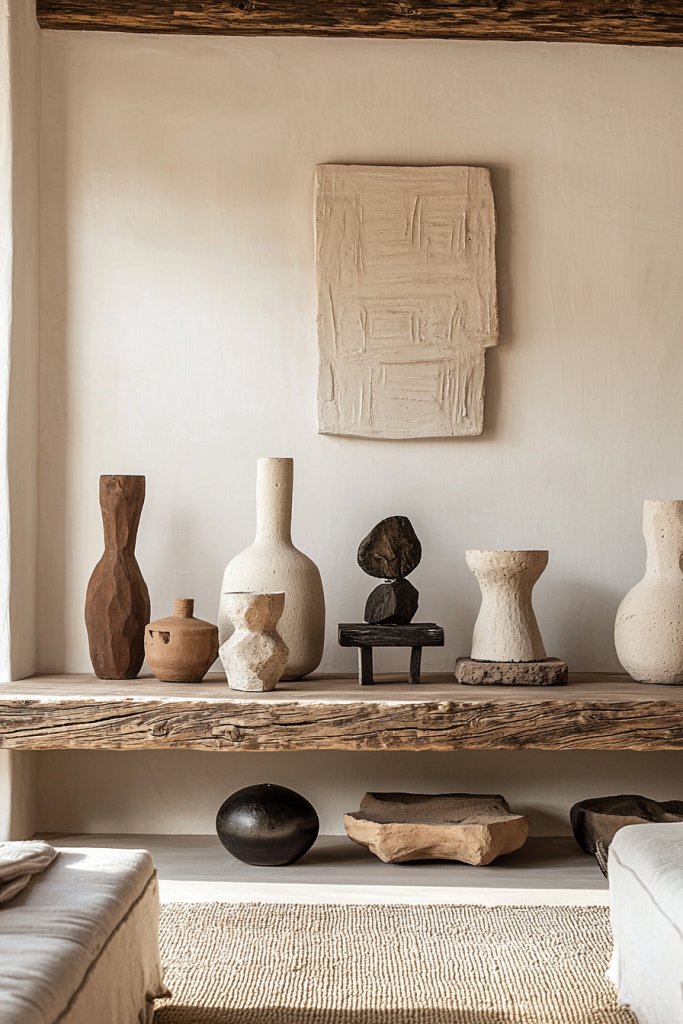
In Wabi Sabi, asymmetry is celebrated as a natural expression of beauty and balance. Arranging decor items in an intentionally uneven, unbalanced way creates visual interest and a sense of organic harmony that feels both relaxed and intentional. This approach encourages viewers to appreciate imperfection and spontaneity in their space.
Imagine a shelf where a small, handcrafted clay vessel sits off-center next to a larger, textured ceramic bowl, with a woven basket or a piece of driftwood placed at varying heights nearby. Alternatively, picture a cluster of mismatched vases in different shapes and muted colors arranged in an irregular pattern on a side table. These asymmetrical compositions foster a dynamic yet calming atmosphere, inviting the eye to explore and find beauty in the imperfect layout.
Start by gathering a variety of objects—ceramics, textiles, natural materials—and experiment with their placement. Avoid symmetrical alignments; instead, aim for visual balance by varying heights, sizes, and textures. Trust your intuition to create arrangements that feel natural and unforced. This mindful, imperfect balance enhances the authentic, tranquil feel of a Wabi Sabi interior, making the space feel both lively and serene.
16. Include Handcrafted, Wabi Sabi-Inspired Pottery or Vases

Bringing handcrafted pottery into your space instantly adds a touch of authentic Wabi Sabi charm, emphasizing the beauty of imperfection and craftsmanship. These pieces serve as both functional and decorative elements that evoke a sense of calm and natural simplicity.
Imagine a collection of irregularly shaped vases with uneven glazes in muted earthy tones—soft browns, gentle greys, and warm clay reds. Their surfaces are often textured, with subtle ridges or dips that showcase the maker’s hand, and each piece feels uniquely imperfect. Placed on open shelves or as table centerpieces, they radiate warmth and a tactile appeal, inviting you to touch and appreciate their raw beauty. The overall effect is a serene, unpretentious aesthetic that celebrates natural materials and craftsmanship.
To incorporate this idea, start by sourcing handcrafted pottery from local artisans, craft fairs, or online marketplaces like Etsy. Choose a few vases or bowls with organic shapes and textured finishes. Arrange them casually on a wooden shelf or a simple side table, pairing them with dried grasses or minimalist bouquets for added natural texture. You don’t need to be an expert—simply select pieces that resonate with your personal style, and enjoy the imperfect beauty they bring to your home.
17. Use Linen or Wool Rugs with Subtle, Irregular Weaves
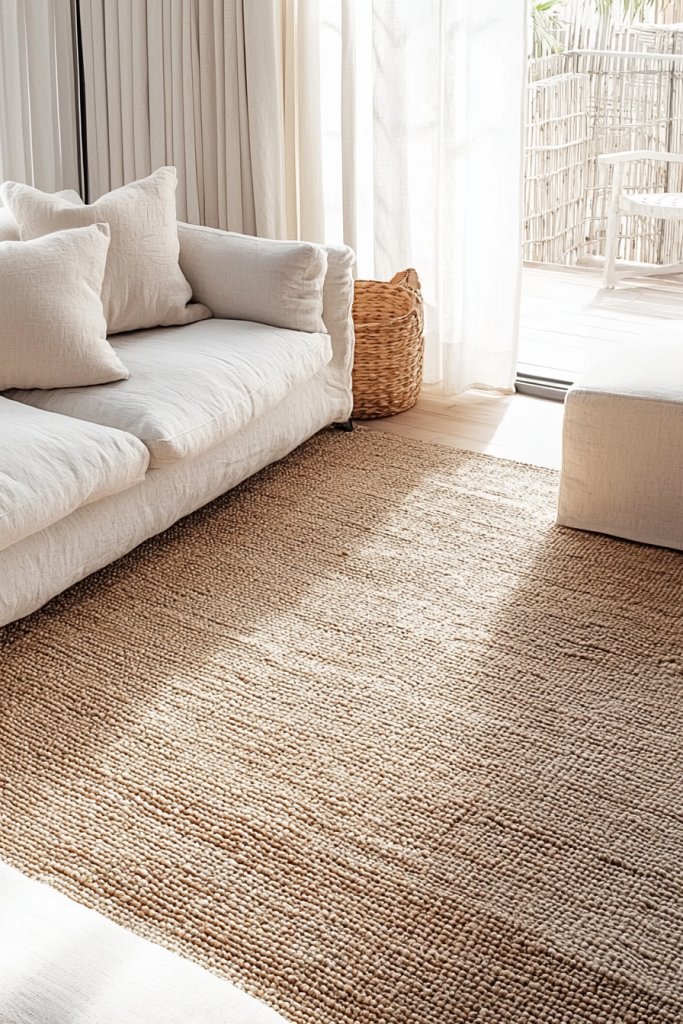
A textured, imperfect rug instantly grounds a Wabi Sabi interior with warmth and subtle visual interest. Linen or wool rugs with irregular, handwoven patterns evoke a sense of natural imperfection and tactile comfort, making your space feel more inviting and authentic.
Picture a soft, natural-colored wool rug with a slightly uneven weave, where tiny variations in thickness and pattern tell a story of handcrafting. The fibers feel plush underfoot, and the muted tones—think warm beige, soft grey, or gentle cream—blend seamlessly with earthy palettes. The irregularity in the weave adds a rustic charm, creating a cozy, lived-in atmosphere that encourages relaxation. Such rugs complement minimalist furniture and textured textiles, enhancing the overall harmony of the space.
To achieve this look, look for rugs labeled as “handwoven” or “handmade,” focusing on natural fibers like wool or linen. You can find affordable options at local markets or online stores specializing in artisanal textiles. When placing the rug, keep it slightly oversized so it anchors your seating area or dining space without feeling cramped. Pair it with neutral-toned cushions or throws to complete the understated, imperfect aesthetic.
18. Incorporate Natural Fiber Window Coverings for Soft, Textural Layers
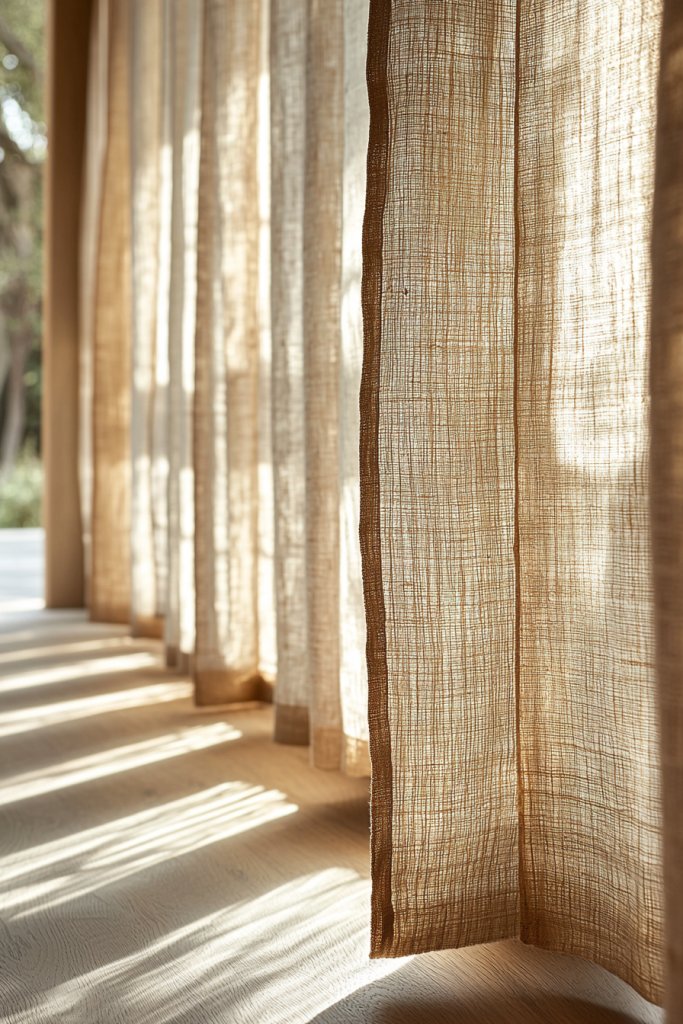
Natural fiber window coverings introduce a gentle, tactile layer that complements the organic ethos of Wabi Sabi interiors. They diffuse light softly, adding warmth and texture to the room while emphasizing the beauty of natural materials.
Imagine sheer, linen or hemp curtains in neutral shades—think soft white, warm beige, or muted grey—that gently sway with the breeze. Their slightly uneven, woven texture adds visual interest without overwhelming the space. These fabrics filter sunlight, creating a calm, cozy ambiance that enhances the overall sense of tranquility. The tactile quality invites you to touch and feel the fibers, reinforcing the connection to nature and imperfection.
To implement, opt for simple, unlined linen or hemp curtains, which are widely available online or at home goods stores. Measure your windows carefully, choosing a length that pools slightly on the floor for a relaxed look. Hang the curtains on a minimalist rod in matte black or natural wood for subtle contrast. Keep the surrounding decor simple, allowing the textured fabric to softly frame your view and add a layered, natural feel to your interior.
19. Showcase Raw, Unpolished Stone or Concrete Surfaces in Countertops and Walls
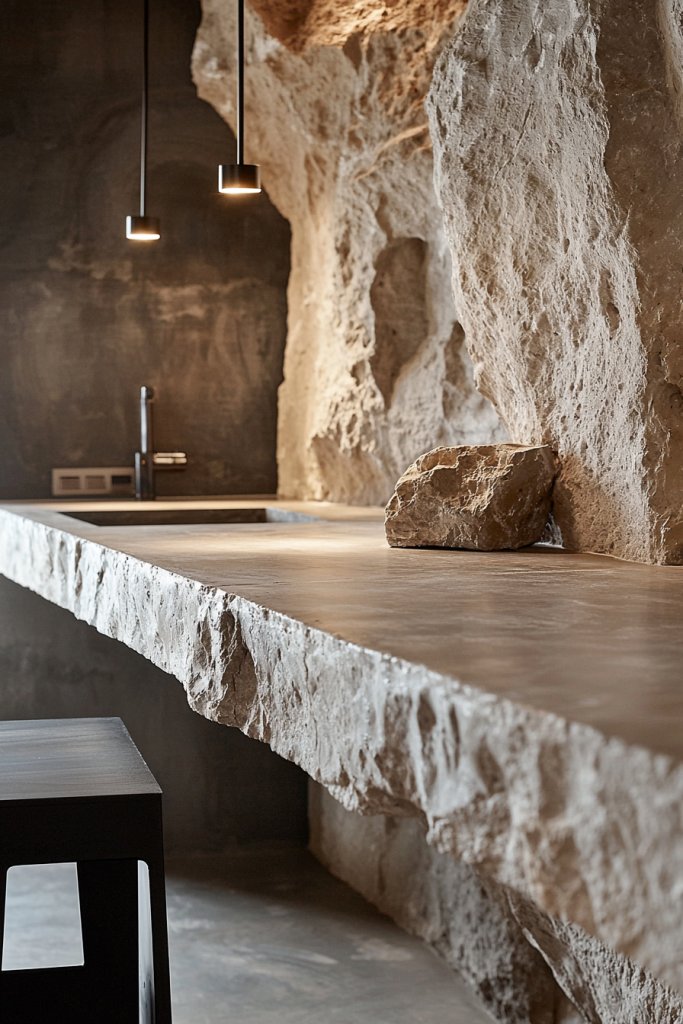
Integrating raw stone or unpolished concrete surfaces into your interior emphasizes the Wabi Sabi appreciation for natural textures and imperfect beauty. These materials create a striking, earthy aesthetic that feels both modern and rooted in nature.
Visualize a concrete countertop with a slightly uneven surface, showing tiny air bubbles and subtle color variations. Or imagine a textured stone wall with rugged edges and visible mineral veins—each surface tells a story of natural formation. These surfaces bring tactile richness, with rough textures that evoke a sense of grounding and authenticity. The neutral, organic tones—think slate grey, warm terracotta, or cool limestone—serve as a perfect backdrop for simple, understated decor.
To incorporate this idea, consider using polished or sealed concrete for countertops or functional surfaces, which is accessible through many DIY kits or professional installers. For walls, exposed stone or concrete panels can be added as feature walls. Keep the surrounding decor minimalist—pair with wood accents, simple ceramics, and soft textiles—to let the raw surfaces stand out and deepen the sense of natural harmony in your space.
20. Integrate Subtle Organic Patterns in Textiles and Accessories
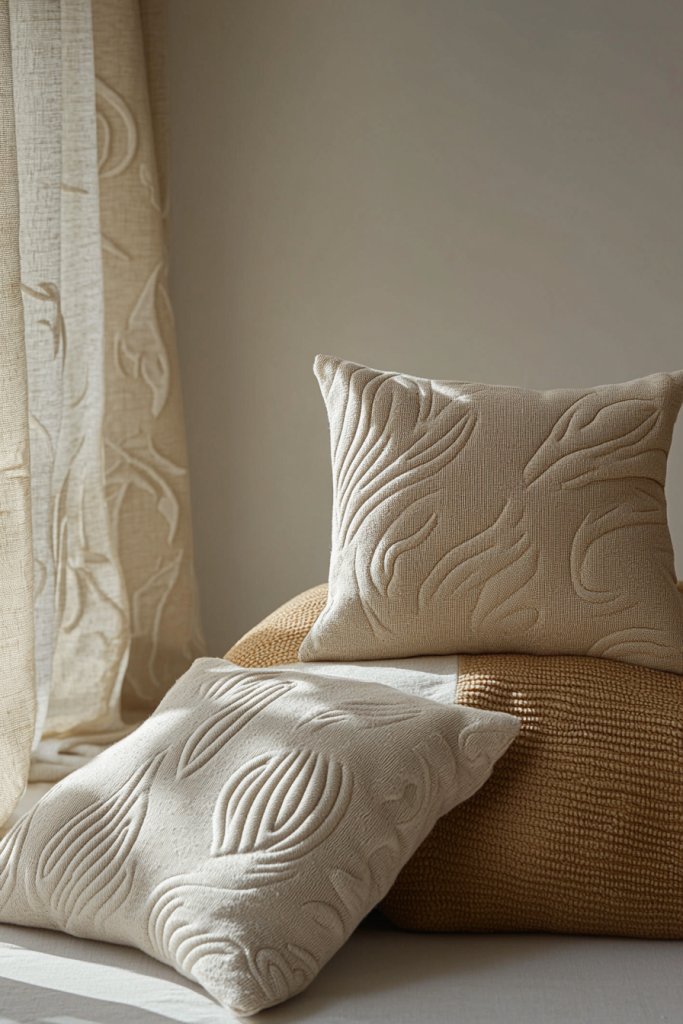
Adding subtle organic patterns in textiles and accessories injects visual interest while maintaining the understated, imperfect aesthetic central to Wabi Sabi. These patterns evoke nature’s irregularities and subtle variations, enhancing a sense of harmony and authenticity.
Picture cushions or throws made from linen or wool, embroidered with delicate, freeform shapes reminiscent of leaves, waves, or clouds. Alternatively, choose accessories like ceramic bowls or baskets with soft, flowing patterns that mimic natural forms. These designs are often understated, with gentle curves and muted color palettes—think soft greens, warm browns, or subtle greys—allowing the textures and irregularities to shine. The overall effect is calming and cohesive, blending seamlessly into a space that celebrates natural imperfection.
To incorporate, select textiles and accessories with organic motifs from boutiques or online shops focused on artisanal or handmade goods. Mix and match different textures and patterns to create a layered, nuanced look. Keep the overall color scheme neutral to let the organic patterns stand out subtly, creating a space that feels both thoughtfully curated and naturally imperfect.
21. Add Distressed or Vintage-Look Metal Light Fixtures and Hardware

Infusing your space with distressed or vintage-inspired metal fixtures instantly adds a layer of character and timeless charm that is central to Wabi Sabi aesthetics. These fixtures evoke a sense of history and imperfection, making your interior feel warm, lived-in, and authentically soulful.
Imagine a wrought iron chandelier with a deliberately weathered finish, its surface showing subtle rust and patina that tell stories of age. The metal hardware—like door handles, drawer pulls, or hooks—appears slightly worn, with uneven paint or oxidized patches that highlight their handcrafted appeal. These elements blend seamlessly with natural textures like rough wood and textured ceramics, creating a cozy, imperfect harmony. The lighting casts soft, warm glows that enhance the space’s organic, relaxed vibe, while the aged metals add visual interest without feeling ornate or overly polished.
To incorporate this idea, start by sourcing vintage or distressed metal fixtures from antique stores, salvage yards, or online marketplaces. For an easy DIY approach, lightly sand or paint modern hardware with matte, chalky finishes to mimic aged metal. Install a vintage-inspired metal light fixture—such as a barn pendant or an industrial sconce—in your living room or entryway. Keep the overall look simple and unpretentious, focusing on the beauty of natural wear and tear that gives your space a unique, timeworn charm.
22. Keep Clutter Minimal and Curate a Few Meaningful Decor Pieces
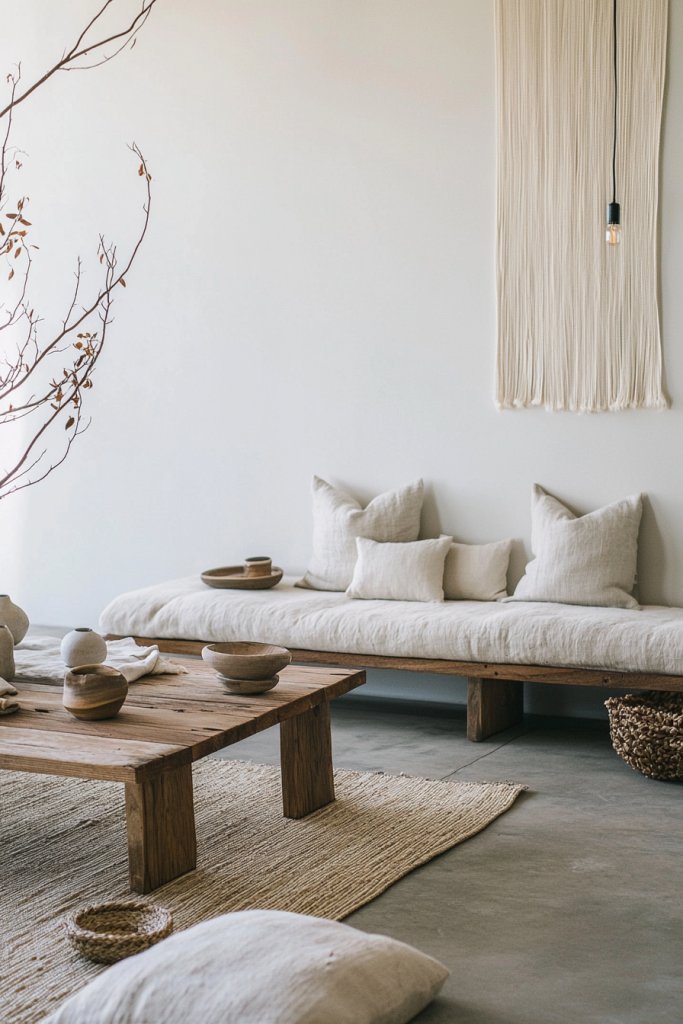
Achieving Wabi Sabi’s essence is rooted in simplicity—creating a space that feels peaceful and authentic by limiting clutter and focusing on meaningful details. This curated approach allows the beauty of each piece to shine and promotes a calming environment.
Visualize a room where only a few carefully chosen objects occupy the space—perhaps a single handcrafted ceramic bowl, a worn leather journal, or a textured linen throw. Surfaces are uncluttered, with negative space giving your eyes room to breathe. Every item has a story or a purpose, and the overall aesthetic is quiet, balanced, and imperfectly beautiful. The focus is on quality over quantity, with each piece radiating a sense of history and authenticity. The space feels inviting yet unpretentious, encouraging relaxation and mindfulness.
To implement, start by decluttering and removing excess possessions. Select a handful of decor items that hold personal significance or showcase natural materials—like a simple woven basket or a rough-hewn wooden sculpture. Limit decorative accessories on surfaces and opt for open, airy arrangements. Regularly reassess your space to keep only those pieces that truly resonate, fostering a serene, clutter-free environment that honors the Wabi Sabi philosophy of beauty in imperfection.
23. Incorporate Natural Elements like Driftwood or Pebbles in Decorative Arrangements
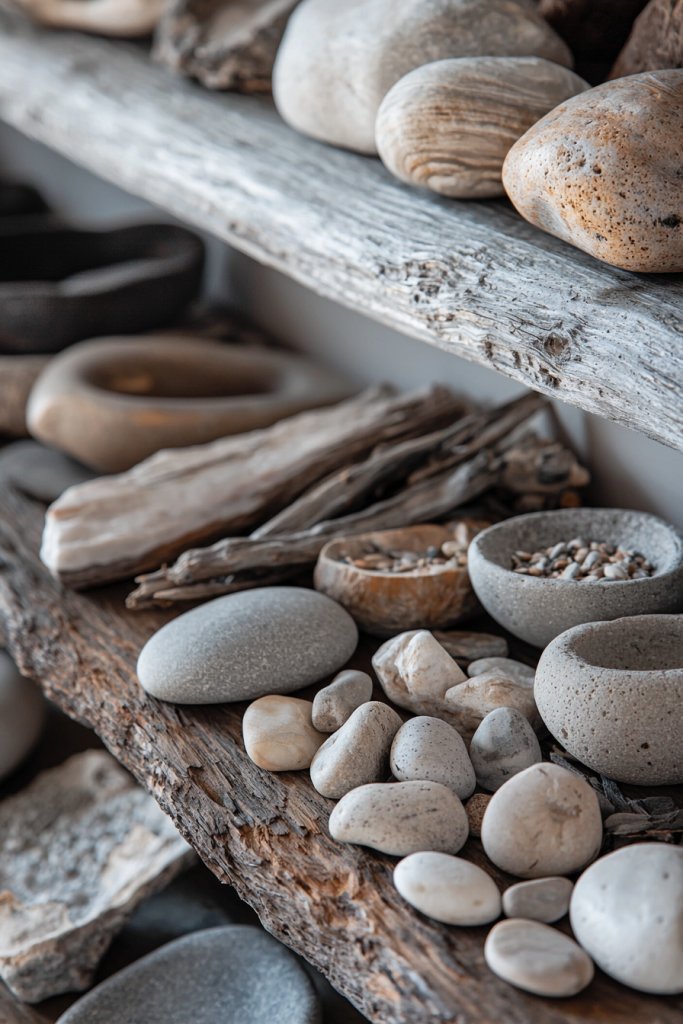
Adding raw natural elements such as driftwood, pebbles, or stones brings an organic, tactile touch that embodies Wabi Sabi’s celebration of nature’s imperfect beauty. These elements create visual interest and connect your interior to the natural world.
Picture a simple bowl filled with smooth, weathered pebbles in earthy tones—gray, beige, and muted browns—arranged casually on a shelf or table. Or imagine a piece of driftwood displayed as a sculpture on a sideboard, its twisted, textured surface inviting touch and reflection. These natural accents evoke a sense of calm and authenticity, with each piece showcasing unique imperfections—cracks, knots, or irregular shapes—that highlight their organic origins. Their understated presence adds depth and a quiet, grounding energy to the space, reminiscent of a peaceful shoreline or forest floor.
To incorporate, gather driftwood and pebbles from local beaches, riverbeds, or parks, ensuring they are clean and dry. Use simple, shallow vessels or trays to display them, or arrange them directly on surfaces for a more organic look. Combine different textures and sizes to create natural, asymmetrical displays. These elements can be rotated or refreshed seasonally, allowing your space to evolve naturally and maintaining a sense of effortless, imperfect beauty.
Conclusion
By embracing imperfect textures, natural materials, and understated elegance, these Wabi sabi interior ideas offer a pathway to creating spaces filled with authentic warmth and harmony. Incorporate weathered wood, handcrafted pottery, organic shapes, and subtle asymmetry to craft a home that celebrates beauty in imperfection. Give these concepts a try and transform your space into a calming retreat that reflects genuine natural beauty. Start today—your perfect imperfect sanctuary awaits.
Leave a Reply